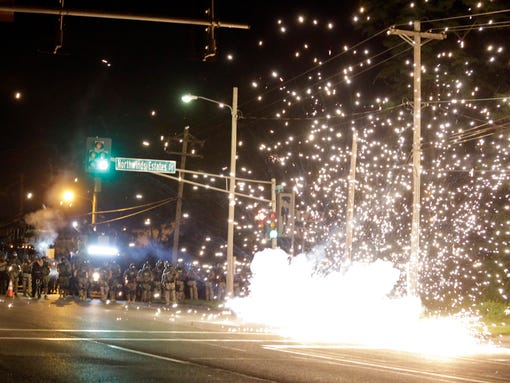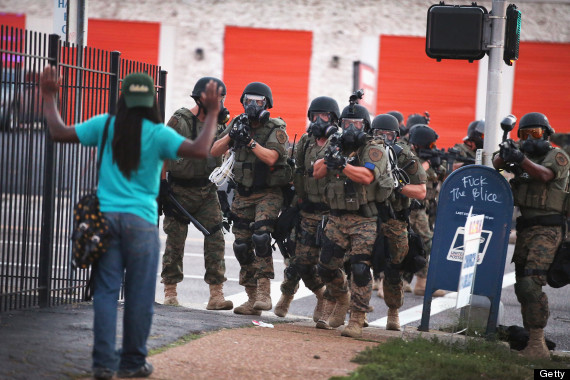On August 9th, 2014, Michael Brown, an unarmed black teenager, was shot and killed by an on-duty police officer, Darren Wilson. In the months that followed the shooting, protests began and continued throughout the city of Ferguson, Missouri, United States, where the killing occurred, and some of those peaceful protests turned into riots, riots that involved the police using tear gas to attempt to get the crowds dispersed. The day after the shooting, a statement was issued by the Ferguson police department, stating that Brown had attacked Wilson, and Wilson shot Brown in self defense. A candle light vigil was held for Brown, and became a violent incident as stores were looted. Police arrived to contain the situation, but when they arrived in large, armored trucks, the people of Ferguson turned against the police. In the days that followed, protests would turn violent and enraged against officers, who would break up even the peaceful protests using tear gas. The protests went on for months, and at the time of the project, December 2014, four months after Michael Brown’s death, people are still protesting.

What brings Ferguson in connection to the events in Northern Ireland is the policing, and the way that situations were handled. The protests both in Derry and in Ferguson turned violent at the sight of officers that had been oppressive or violent to the protesters, to which the officers would respond- and their response would be overtly forceful, and uncalled for- shooting at unarmed citizens, and tear gassing protesters and marching on them in an attempt to intimidate them.
It’s hard not to look at the events in Ferguson without looking at them in terms of race. As of the 2010 census, 67% of the population was Black. 92% of those who were arrested for disorderly conduct are black. 53 people work in the Ferguson police department, and of those 53 men and women, 3 of them are black. Of the 12 members of the grand jury that decided not to indict Darren Wilson in Michael Brown’s death, 3 of them were black. Even if you want to argue that Brown’s death had nothing to do with race, it’s hard to look at these demographics and not see that something is not right.
The tactics officers deployed in Ferguson were aggressive and terrifying- people compared them to tactics used in “a war zone“. Protesters were terrified to see that the weapons being used against them were automatic rifles, and to see police donning riot gear as they marched the streets along side armored trucks. Tear gas was launched into crowds of peaceful demonstrators and journalists; “they’re treating demonstrators—and Ferguson residents writ large—as a population to occupy, not citizens to protect.” And if the fact that terrorizing American citizens wasn’t bad enough- the cost of the policing reached $11.7 million in early December 2014. Thats not to say that the treatment of the protesters is lesser than the amount of money spent, but rather to pose this question:
Why are police officers in Ferguson spending approximately $2.93 million in three months, trying to break up protests?

And these moments seen in Ferguson only bring further similarities between the LA Riots, Bloody Sunday, and Ferguson to light.
Much like in Northern Ireland on Bloody Sunday, police strength was used over the protesting oppressed people, trying to be peaceful but having a handful “hooligans” or “thugs” taking things to the extreme with looting and rioting. No one knew the names of the paras and militants that took part of the violence that day, after Darren Wilson’s named was released (six days after the shooting), police officers in Ferguson removed their name tags; as of September 29th, over a month since Brown’s death, they were still not wearing them.

In Eyewitness Bloody Sunday, Patrick Friel was headed to join the march when he passed by three army vehicles. From one of them, he heard “You’ll get it today you bastards”*, which they interpreted as an idle threat, until everything went so horrible wrong. In Ferguson, a police officer threatened a protester, saying “I will f—— kill you.”
https://www.youtube.com/watch?v=8zbR824FKpU
“Then a fellow came out with a white flag, no sooner had he done this when the middle one of three British soldiers pulled the trigger and shot him in the head.”** This moment happened during Bloody Sunday, when the worst of the attack was occurring. The man was obviously showing that he meant no harm, and that he was surrendering- despite the fact that he never attacked- but whoever shot him didn’t care. In Ferguson, and all throughout the united states (including the Saint Louis Rams), protesters have taken up the cry of “Hands up, don’t shoot”.

Unlike Ireland, however, the events in Ferguson and other major parts of the country are widely documented and discussed. Vines and youtube videos of the protests and riots are viewed by the millions. Twitter is filled with tweets from reporters at the scene and citizens of Ferguson. There are hundreds of first hand reports out there of what is happening in Ferguson today, and the people who live throughout the rest of the united states follow all sources and learn all they can about what happened there, not just believing what was said by officials.
After events like these, questions are left behind.
What has led to extreme action being the first response? What caused this knee-jerk reaction?
Occupy Wall Street was a peaceful protest that took place in 2011, protesting structural inequality between the majority wealth holders, “the 1%” and the rest of the world. Why didn’t the police get violent during this protest? What is the difference in their minds between protesting a death versus protesting wealth issues?
Sources:
*-Mullan, Don. Eyewitness Bloody Sunday. Dublin: Wolfhound, 1997. 73. Print.
**- Mullan, Don. Eyewitness Bloody Sunday. Dublin: Wolfhound, 1997. 118-119. Print.
Other Sources:
- Timeline of Ferguson events, from August 9th, 2014 to November 24th, 2014.
- In-depth explanation of the shooting
- Antonio French’s Vine account, as he continues to post clips of the events occurring in Ferguson
- Timeline of the shooting in detail
- Hands Up United, an organization advocating for Michael Brown
Roadmap


One Reply to “Policing in Northern Ireland: Ferguson”